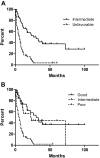Acute erythroid leukemia: a reassessment using criteria refined in the 2008 WHO classification
- PMID: 20040759
- PMCID: PMC2942006
- DOI: 10.1182/blood-2009-09-243964
Acute erythroid leukemia: a reassessment using criteria refined in the 2008 WHO classification
Abstract
Acute erythroid leukemia (AEL) is a rare type of acute myeloid leukemia (AML) for which diagnostic criteria have been refined in the 2008 World Health Organization (WHO) classification of AML. The relationship of AEL to myelodysplastic syndromes (MDSs) and to AML with myelodysplasia-related changes (AML-MRC) is not clearly defined. We conducted a retrospective, multi-institutional study of patients with AEL and compared them with patients with MDS or AML-MRC with erythroid hyperplasia (> or = 50% erythroid cells). Among a total of 124 patients with AEL, 32% had a history of MDS or chronic cytopenia, 32% had therapy-related disease, and 35% had de novo disease. Sixty-four percent of patients had unfavorable AML risk-group karyotypes. FLT3 and RAS mutations were infrequent, occurring in 6% and 2%, respectively. The median overall survival (OS) of all AEL patients was 8 months, comparable with that of patients with MDS or AML-MRC with erythroid hyperplasia. The OS was related to cytogenetic risk group, but not blast count or morphologic dysplasia. Our findings suggest that AEL is in the continuum of MDS and AML with erythroid hyperplasia, where karyotype rather than an arbitrary blast cutoff represents the most important prognostic factor.
Figures




References
-
- Bennett JM, Catovsky D, Daniel MT, et al. Proposed revised criteria for the classification of acute myeloid leukemia: a report of the French-American-British Cooperative Group. Ann Intern Med. 1985;103(4):620–625. - PubMed
-
- Brunning RD, Matutes E, Flandrin G, et al. Acute myeloid leukaemia not otherwise categorised. In: Jaffe ES, Harris NL, Stein H, Vardiman JW, editors. World Health Organization Classification of Tumours. Lyon, France: IARC Press; 2001. pp. 91–105.
-
- Arber A, Brunning RD, Orazi A, et al. Acute myeloid leukaemia with myelodysplasia-related changes. In: Swerdlow SH, Campo E, Harris NL, et al., editors. WHO Classification of Tumours of Haematopoietic and Lymphoid Tissues. Lyon, France: International Agency for Research on Cancer; 2008. pp. 124–126.
-
- Zuo Z, Kasyan A, Chandra P, Medeiros J, Koeppen H. Acute erythroid leukemias: histologic, cytogenetic, and molecular characterization [abstract]. Lab Invest. 2009;89(S1):293A.
-
- Park S, Picard F, Dreyfus F. Erythroleukemia: a need for a new definition. Leukemia. 2002;16(8):1399–1401. - PubMed
Publication types
MeSH terms
Grants and funding
LinkOut - more resources
Full Text Sources
Other Literature Sources
Research Materials
Miscellaneous

